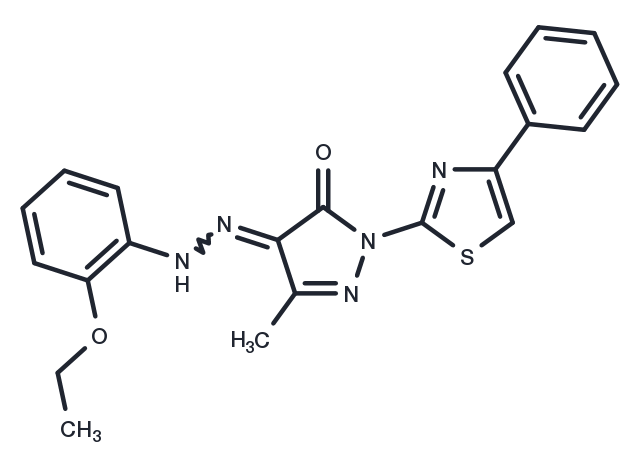Powder: -20°C for 3 years | In solvent: -80°C for 1 year


BAM 7 is a direct and specific activator of proapoptotic Bax (EC50: 3.3 μM).

| Pack Size | Availability | Price/USD | Quantity |
|---|---|---|---|
| 1 mg | In stock | $ 32.00 | |
| 5 mg | In stock | $ 73.00 | |
| 10 mg | In stock | $ 103.00 | |
| 25 mg | In stock | $ 217.00 | |
| 50 mg | In stock | $ 395.00 | |
| 100 mg | In stock | $ 593.00 | |
| 1 mL * 10 mM (in DMSO) | In stock | $ 82.00 |



| Description | BAM 7 is a direct and specific activator of proapoptotic Bax (EC50: 3.3 μM). |
| Targets&IC50 | Bax:3.3 mM(EC50) |
| In vivo | In vitro experiments show that BAM7 induces BAX-mediated pore formation, BAX oligomerization, and BAX-dependent cell death. By activating BAX within cells, BAM7 selectively triggers BAX-mediated apoptosis. Its efficacy is limited to cells containing BAX, where it induces the biochemical and morphological hallmarks of BAX-mediated apoptosis. BAM7 binds directly to the N-terminal BH3 domain of BAX, facilitating interaction at the surface and BAX activation via the BIM BH3 helix. Moreover, BAM7 dose-dependently and temporally triggers the conversion of BAX from monomers to oligomers. |
| Kinase Assay | Fluorescence polarization binding assays: Direct binding curves are first generated by incubating FITC-BIM SAHB (50 nM) with serial dilutions of fulllength BAX, BCL-XLΔC, MCL-1ΔNΔC, BFL-1/A1ΔC or BAKΔC and fluorescence polarization measured at 20 minutes on a SpectraMax M5 microplate reader. For competition assays, a serial dilution of small molecule or acetylated BIM SAHB (Ac-BIM SAHB) is combined with FITC-BIM SAHB (50 nM), followed by the addition of recombinant protein at ~EC75 concentration, as determined by the direct binding assay (BAX, BAKΔC: 500 nM; BCL-XLΔC, MCL-1ΔNΔC, BFL-1/A1ΔC: 200 nM). Fluorescence polarization is measured at 20 minutes and IC50 values calculated by nonlinear regression analysis of competitive binding curves using Prism software. |
| Cell Research | MEFs (2.5 × 103 cells per well) are seeded in 96-well opaque plates for 18-24 h and then incubated with serial dilutions of BAM7, ANA-BAM16 or vehicle (0.15% (v/v) DMSO) in DMEM at 37 °C in a final volume of 100 μL. Cell viability is assayed at 24 h by addition of CellTiter-Glo reagent according to the manufacturer's protocol, and luminescence is measured using a SpectraMax M5 microplate reader. Viability assays are performed in at least triplicate, and the data are normalized to vehicle-treated control wells.(Only for Reference) |
| Molecular Weight | 405.47 |
| Formula | C21H19N5O2S |
| CAS No. | 331244-89-4 |
Powder: -20°C for 3 years | In solvent: -80°C for 1 year
DMSO: 4.1 mg/mL (10 mM)
You can also refer to dose conversion for different animals. More
bottom
Please see Inhibitor Handling Instructions for more frequently ask questions. Topics include: how to prepare stock solutions, how to store products, and cautions on cell-based assays & animal experiments, etc.
BAM7 331244-89-4 Apoptosis BCL Bcl-2 Family BAM-7 Inhibitor inhibit BAM 7 inhibitor
